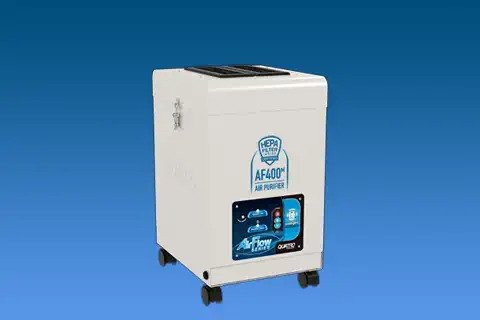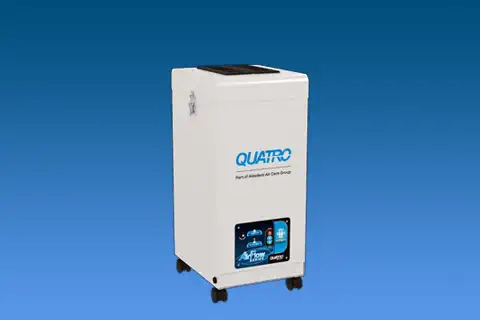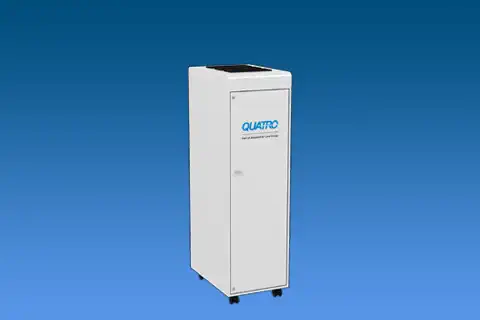Offices
Overview
 The average employee spends a quarter of his life or more in his office environment. That’s why it is essential that the indoor air quality (IAQ) at work meets the appropriate standards to keep workers healthy and productive. The World Health Organization (WHO) estimates that indoor air is 8 times more polluted than outdoors. But that number may be considerably higher in offices with open-plan work spaces which can be as much as 10 to 20 times that rate.
The average employee spends a quarter of his life or more in his office environment. That’s why it is essential that the indoor air quality (IAQ) at work meets the appropriate standards to keep workers healthy and productive. The World Health Organization (WHO) estimates that indoor air is 8 times more polluted than outdoors. But that number may be considerably higher in offices with open-plan work spaces which can be as much as 10 to 20 times that rate.
Studies by the Environmental Protection Agency (EPA) indicate indoor pollutants to be a serious problem and a major contributor to reduced employee productivity and increased absences. It is estimated that tens of billions of dollars are lost each year due to poor IAQ.
Air Quality Challenges
Poor air quality can take a toll on worker health. Symptoms of long-term exposure to indoor pollutants include:
- Lack of Focus
- Dizziness
- Allergy Symptoms (Coughing, Sneezing, Runny Nose)
- Sore Throat
- Fatigue
- Headache
If exposure persists long enough, the health consequences can be much more alarming. Cancer, heart disease and respiratory disease have all been associated with exposure to indoor air pollutants.
The major pollutants contributing to poor IAQ in offices include:
- Mold and Mildew
- Chemical Pollutants
- Viruses and Bacteria
- Carbon Dioxide Levels
- Indoor Particulate and Dust
- Cigarette Smoke
Mold and Mildew
Dampness can build up in offices due to water spills, roof and plumbing leaks or condensation on windows in winter. That moisture can lead to the growth of mold or mildew which contaminates indoor air.
Containing poisonous spores, mold is quite dangerous if inhaled. Symptoms associated with mold exposure include:
- Respiratory Issues
- Coughing
- Wheezing
- Allergic Rhinitis
- Headache
- Dizziness
- Poor concentration
- Nose Bleeds
- Rashes
The Occupational Safety and Health Association (OSHA) does not have standards for IAQ, but it does have regulations for toxins affecting IAQ- mold being one of them. To help protect employees from mold exposure, employers can refer to the OSHA website for comprehensive guidelines on mold prevention and removal.
Chemical Pollutants
Offices engage in a number of processes on a daily basis that emit harmful chemicals that contribute to poor air quality. Printing and copying release toxic gasses such as nitrogen dioxide, ozone and other volatile organic compounds (VOCs). VOCs such as formaldehyde, fire retardants, benzene and acetone, are also produced by the off gassing of furniture, carpeting, wall hangings and even some perfume and cosmetic products worn by coworkers. New buildings in particular, can expose workers to even higher levels of these harmful compounds.
Inhalation of VOCs can cause fatigue, irritability, brain fog and eye, nose and throat irritation. High levels of exposure are far more dangerous and can lead to:
- Skin Irritation
- Neurotoxic effects
- Liver toxicity
- Cancer
Other chemicals, such as solvents and ozone from cleaners, paint and glues also contribute to poor IAQ in offices.
Viruses and Bacteria
Since the COVID-19 pandemic, employers have become more aware of the need to protect workers from the spread of respiratory viruses and other bacteria. The greater the office occupancy, the more the employees are at risk of infection. Without proper air filtration, bacteria and viruses can proliferate and linger indoors, sometimes for hours at a time, and infect more people.
Carbon Dioxide Levels
Carbon dioxide levels can also negatively impact IAQ. Indoor spaces with high CO2 have been shown to adversely affect people’s health. If allowed to accumulate, CO2 can cause drowsiness, fatigue, headaches, dizziness and respiratory problems.
The American Society of Heating, Refrigerating, Air-Conditioning Engineers (ASHRAE) states that CO2 concentrations should be lower than 1000 parts per million (ppm) to maintain good air quality. Installing a system that filters and ventilates the air is essential to keep CO2 levels down.
The American National Standards Institute (ANSI)/ American Society of Heating, Refrigerating and Air Conditioning Engineers (ASHRAE) have guidelines for ventilation system design for acceptable IAQ. Standards 62.1 and 62.2 outline minimum ventilation rates and other measures businesses can take to curtail the adverse health effects of poor air quality.
Indoor Particulate and Dust
Particles are solid or liquid substances that include dust, dust mites, pollen, sulfates, metals and dirt. Light enough to suspend in the air, the largest particles can be seen with the naked eye in a ray of sunlight. It’s the smaller ones that you can’t see that pose the biggest inhalation hazard, as they can pass right through the nasal cavities and into the lungs.
Some particulate matter is brought in from outdoors but some originates from indoor office activities such as printing, copying and other equipment. Without a proper air purifier with HEPA filtration in place, these particles can circulate throughout an office and trigger allergy symptoms in some workers.
Cigarette Smoke
Many states and provinces have banned smoking indoors but that doesn’t mean indoor office air is free of cigarette fume contamination. Cigarette smoke can linger on a smoker’s skin and clothes and impact IAQ in offices. Containing more than 4,000 toxic compounds, chemicals from cigarette smoke have the potential to damage the respiratory systems of workers over time.
Solutions for Offices
IAQ is so important in maintaining worker health that in a report by the Harvard T.H.Chan School of Public Health, it was listed as one of the nine key foundations for a healthy office building. To keep employees happy, healthy and productive, investing in a good quality air purifier to remove indoor toxins is essential.

AF 400M
HEPA Air Purifier
A portable air purifier for localized chemical, odor and particle removal. 300 nominal CFM.
Get Product Details
AF 400
HEPA Air Purifier
Compact and powerful, the AF400 is ideal for localized chemical, odor and particle removal. 300 nominal CFM.
Get Product Details
AF 1000
HEPA Air Purifier
Enhanced protection against airborne pollutants including chemicals, gases, odors and particles. 600 nominal CFM.
Get Product Details
AF 2000
HEPA Air Purifier
Designed to handle high concentrations of chemicals, gases, odors, particles and biological contaminants. 1000 nominal CFM.
Get Product Details